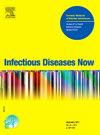Management of catheter-related septic thrombosis
IF 2.2
4区 医学
Q2 INFECTIOUS DISEASES
引用次数: 0
Abstract
Introduction
The use of intravascular catheters is associated with a risk of catheter-related septic thrombosis (CRST), which management remains highly variable due to a lack of robust scientific evidence. This study aimed to describe current practices in France through a systematic survey.
Methods
A web-based survey was disseminated via 10 French medical societies between June and October 2024.
Results
Among 156 respondents, 69 were infectious disease specialists. For catheter-related bloodstream infections, ultrasound imaging is not routinely performed by 60 % of respondents but is typically performed in the presence of local inflammatory signs or antimicrobial therapy (AMT) failure. Over 60 % of respondents reported prescribing AMT for ≤ 21 days. In cases of CRST involving a deep vein (DV), more than 80 % of respondents considered the use of curative anticoagulation. For proximal DV CRST, 126 of 156 (81 %) respondents performed follow-up ultrasound imaging to assess venous repermeabilization. The most frequently cited research priorities included the need for and appropriate use of anticoagulation (n = 71/156; 46 %), as well as AMT optimal duration (n = 47/156; 30 %).
Conclusion
Despite the heterogeneity in clinical practice, our findings highlight a prevailing trend toward prescribing AMT for ≤ 21 days and the use of curative anticoagulation in cases of DV thrombosis. However, these approaches require further investigation through well-designed studies to establish their benefit.
导管相关脓毒性血栓的处理。
导言:血管内导管的使用与导管相关性脓毒性血栓形成(CRST)的风险相关,由于缺乏强有力的科学证据,其管理仍然存在很大的差异。本研究旨在通过系统调查来描述法国目前的做法。方法:于2024年6月至10月通过法国10个医学学会进行网络调查。结果:156名被调查者中,69名是传染病专家。对于导管相关血流感染,60% 的应答者不常规进行超声成像,但通常在存在局部炎症体征或抗菌治疗(AMT)失败时进行超声成像。超过60% %的应答者报告在 ≤ 21 天内开AMT处方。在涉及深静脉(DV)的CRST病例中,超过80% %的应答者考虑使用治疗性抗凝。对于近端DV CRST, 156名受访者中的126名(81 %)进行了随访超声成像以评估静脉再渗透。最常被引用的研究重点包括抗凝的需要和适当使用(n = 71/156;46 %),以及AMT的最佳持续时间(n = 47/156;30 %)。结论:尽管在临床实践中存在异质性,但我们的研究结果强调了在DV血栓形成病例中,处方AMT ≤ 21 天和使用治愈性抗凝治疗的普遍趋势。然而,这些方法需要通过精心设计的研究来进一步调查,以确定它们的益处。
本文章由计算机程序翻译,如有差异,请以英文原文为准。
求助全文
约1分钟内获得全文
求助全文
来源期刊

Infectious diseases now
Medicine-Infectious Diseases
CiteScore
7.10
自引率
2.90%
发文量
116
审稿时长
40 days
 求助内容:
求助内容: 应助结果提醒方式:
应助结果提醒方式:


